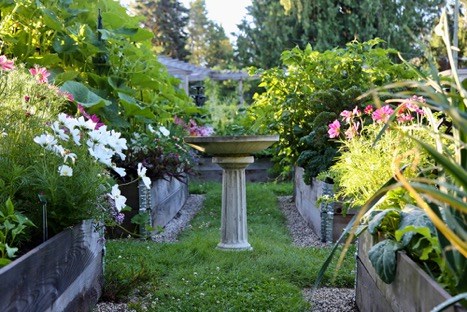Conversations with new gardeners tend to focus on raised beds, specifically ‘no dig’ raised beds. I receive many emails inquiring about materials and methodology.
For most people, simplicity, economy, and longevity are primary concerns. I recommend using inexpensive untreated or organically treated cedar to build open-bottom raised beds, and source planters made of steel, stone, or untreated wood.
While it may seem counterintuitive, later summer and fall are the perfect times to prepare for the 2022 gardening season. Creating new no-dig beds now to rest over the winter makes sense.
If you observe nature during these next few months, through to first frost, you will see that she is in fact very busy getting a jump on spring. We can emulate this natural logic by top-dressing organic base soil with organic compost before winter takes root, to allow the still-warm weather to kick-start fungi, microbes and other microorganisms into creating luscious soil.
Rain and melting snow will wash high concentrates of salts from contained animal manures, helping to balance living soil for spring planting. Cover crops like winter field peas provide masses of organic mulch matter, fix nitrogen, and look beautiful.
No-dig garden beds and containers are fundamental to urban permaculture. Whether you garden in a yard, on a rooftop, or in a shared plot, your efforts will be more productive, beautiful and righteous if you adopt a no-dig philosophy.
Why? Because at its roots, no-dig mimics nature's logic. In natural ecosystems undisturbed by human intervention, nature top-dresses the soil from above and from the forest canopy, while simultaneously and invisibly conducting a symphony of beneficial relationships below ground. Happy 'contained' soil looks very much like moist chocolate cake, offering a deep brown-black damp and delicious sticky sponginess.
This is no accident. Healthy soil is busy soil, supporting an ecosystem of visible and microscopic organisms whose job it is to decompose plant residue and carry out a range of important functions. The less disturbed (tilled, dug) the soil, and the greater the amount of beneficial organic matter retained, the more plant residue and food there is to support biological activity.
Worms feed on decomposing plant matter, and as they move through and poop in the soil they aerate and fertilize at the same time, contributing to the sponge and structure. In circulating, feeding and pooping, worms and larger insects are captive, living recyclers of soil.
Tiny microfauna like protozoa and nematodes, and microflora like fungi and bacteria are equally important to soil biology and play specific roles within the biomass of the soil.
I do not dig, turn over, or otherwise unnecessarily disturb the soil, and I never use synthetic fertilizers or insecticides that would harm organisms and kill or harm soil biology. With few exceptions, we harvest plants at soil level by cutting the stems and leaving the root structure to decompose naturally and become food for organisms.
Disturbing the soil can damage or destroy the airy network of tunnels that worms and insects worked so hard to create, and it breaks the mycelial network of fungal hyphae (mushrooms are the fruiting bodies of this underground network) that can traverse thousands of miles back and forth through the soil contained in a single small bed. This network creates mutually beneficial relationships with plant roots and root hairs, exchanging nutrients and minerals, and increasing the nutrient and moisture absorbing surface area and capabilities of the roots.
When nature composts from the top with leaf litter and decaying matter, organisms in the soil come to the surface to feed and pull the matter down below the soil – aerating and adding structure in the process – and the decomposition process is enhanced.
We have smaller galvanized steel feed-trough planters that have supported very healthy tomato plants, fruit trees, and root vegetables for well over a decade. I never dig them, but I do top-dress generously, annually, with organic compost. Soil levels drop naturally, as organisms and plants feed on the soil, breaking it down and turning it into food for my family.
It is miraculous really, what goes on down below and over time, and how intelligent the soil web of life really is. Who are we to mess with perfection?
Laura Marie Neubert is a West Vancouver-based urban permaculture designer. Follow her on Instagram @upfrontandbeautiful, learn more about permaculture by visiting her Upfront & Beautiful website or email your questions to her here.
For a taste of permaculture, click on the YouTube link below:



